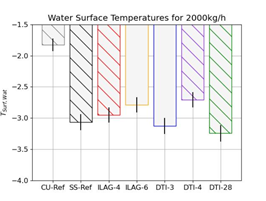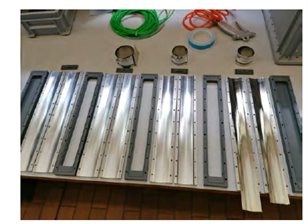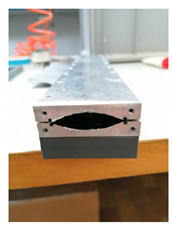Testing of coated tubes in a flow test rig
In order to develop a reliable supercooler for a 10 kW heat pump system, experimental setups were constructed to mimic the relevant operation conditions with water flows. Based on the results of the static conditions, the most promising coatings and bulk materials were selected to be tested under flow conditions. In total, five coatings and five amorphous metals were tested under relevant operation conditions.
Coatings were applied on copper and steel tubes mounted concentrically inside a transparent poly(methyl methacrylate) (PMMA) pipe on the experimental setup at SPF’s facilities (see image below). The heat transfer fluid (glycol) was circulated inside the tube and cooled by a chiller in a step-wise manner. The water flowing between the outside of the coated tube and the transparent pipe was cooled down until freezing was detected. The temperature of the coldest water tube surface was determined by a combined method using measurements on the brine and water side and a simulation model based on Computational Fluid Dynamics (CFD). Measurements were done at two different water mass flows of 1000 kg/h and 2000 kg/h. As reference, uncoated copper and stainless steel tubes were also tested.
The results (see image below) show improvements in the range of 40 % to 70 % on the supercooling performance between uncoated and coated copper tubes. This was mainly attributed to the capabilities of the coatings, regardless of their icephobic performance, to smoothen the surface and cover surface defects.

However, improvements of coatings respect to a polished stainless steel (SS) tube are not that clear. The best coating improved the ice depression capabilities by 20 % respect to SS for 1000 kg/h, but smaller improvements in the range of 6 % are observed at 2000 kg/h. In general, differences of ice depression at 2000 kg/h for SS and all coatings are rather small. This might indicate that the fluid regime could be a very important factor in ice depressing capabilities. High mass flows and thus, a turbulence regime, might reduce the ice depression capabilities of the icephobic coatings. It might also be that turbulence enhance the surface defects such that these dominate the ice depression behaviour. It should be noted that some of the defects appeared due to a surface scratching on the mounting procedure of the tube on the setup, and thus have little to do with coating application or coating durability. In summary, ice depression difference between coatings was less prominent in those experiments compared to those at sample level shown in the image below. However, current experiments with complete heat exchanger show very promising results for icephobic coatings. The reason why in tube experiments the improvements of coatings are small demands further investigations.


In case of bulk materials, the metallic amorphous approach was pursued. A special tube-like supercooler was developed in order to test the most promising amorphous band strip materials. The experimental tube-like supercooler was mounted in the test setup, where a cold brine was supercooling the water in the heat exchanger. In this setup, the water temperature was measured in the free jet. As expected, due to the small dimensions of the tube-like heat exchanger, the achieved supercooling was small. Furthermore, two of the three selected materials corroded (see the table below). This might be explained by long term exposure of iron in water (see main constituent in the table below).
Since those experiments were not found to be successful, a new method was tested that could be applied on plate heat exchangers. In all the amorphous metals selected, nickel was found to be present. Thus, it was considered to be a promising material for surface treatment. An electroless high phosphorous nickel treatment also creates an amorphous surface, while having a high heat conductivity and low adhesion force if ice is forming on the surface. A coaxial tube with four fluid connected nickel treated tubes were installed in the experimental setup.
Results show a potential increase of the supercooling performance respect to a bare metal. However, the improvements were not as large as expected on these experiments and further studies will be necessary. This method to create an amorphous nickel surface is also feasible for brazed plate heat exchanger, which is why this procedure will be used for the following tests with the supercoolers.


